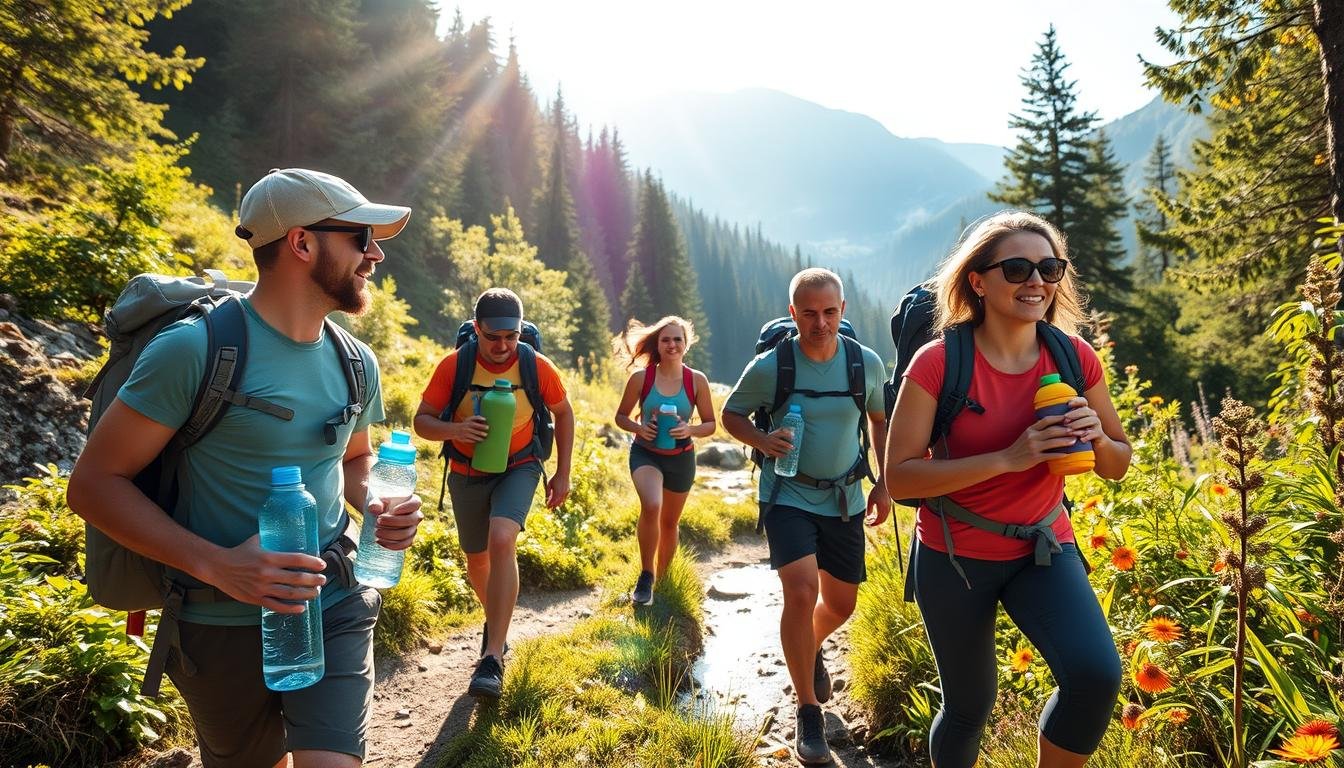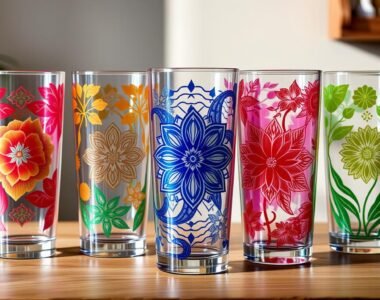No products in the cart.

Going on a hike, whether it’s tough or easy, means you need to stay hydrated. Good hydration strategies help keep your energy up and prevent dehydration. This is key to enjoying your hike and doing well.
It’s important to have clean, safe water when you’re hiking. Knowing the best water for long hikes helps you avoid risks. Taking care of your hiking hydration needs makes your adventure better.
Key Takeaways
- Implement effective hydration strategies for optimal performance.
- Proper hydration is critical for maintaining energy levels during hikes.
- Select and manage water sources to ensure safety and adequacy.
- Understand the benefits of staying hydrated on rigorous treks.
- Avoid the detrimental effects of dehydration by preparing well.
Importance of Hydration During Hiking
Staying hydrated is key for good hiking performance and endurance. Drinking enough water helps avoid dehydration. Dehydration can be very harmful for hikers.
How Dehydration Affects Performance
Dehydration hurts your brain and muscles. When you lose more water than you drink, your body can’t cool down or work right. For hikers, this means less energy and faster tiredness.
Not drinking enough water can also make you dizzy and slow. This makes it dangerous to keep hiking.
Signs You’re Dehydrated
Knowing the signs of dehydration is important. Here are some common ones:
- Fatigue and weakness
- Dry mouth and throat
- Headaches and dizziness
- Dark-colored urine
- Increased heart rate
By watching for these signs, hikers can drink more water. This helps keep their performance and endurance up on the trail.
Types of Water Sources on the Trail
When you go hiking, knowing about natural water sources is key for safety. These sources keep you hydrated and let you enjoy nature.
Streams and Rivers: Nature’s Refreshment
Streams and rivers are great for finding water on the trail. Their constant flow means less chance of dirty water. Look for fast-moving water to stay safe.

Rainwater Collection and Safety
Rainwater is a good choice when other water sources are scarce. Use clean containers and avoid dirty water to collect it safely. Sterilizing the water makes it safe to drink.
Water from Lakes and Ponds
Lakes and ponds are common but need careful use. They can have dirty water. Look out for algae or animal signs and always purify the water.
Choosing the right water source depends on where you are and what’s safe. Here’s a quick guide:
| Water Source | Advantages | Disadvantages |
|---|---|---|
| Streams and Rivers | Continuous flow, generally cleaner | Requires proximity to trail, possible pollutants upstream |
| Rainwater | Readily available during rains, easy to collect | Requires collection setup, potential contamination |
| Lakes and Ponds | Abundant in certain areas, larger volume | Potential bacterial contamination, requires filtration |
Knowing about different water sources makes hiking safer and more enjoyable. It helps you stay hydrated too.
Carrying Water: Options and Considerations
When planning a long hike, how you carry water is key. You can choose between water bottles and hydration packs. Each has its own benefits and drawbacks, affecting your hike. Let’s explore the details to guide your choice.
Water Bottles vs. Hydration Packs
Water bottles are popular for their ease and variety. Brands like Nalgene and CamelBak offer durable options. Hydration packs, with their built-in reservoir and tube, offer hands-free drinking. They’re great for convenience and even weight.
“Choosing the right hydration gear is essential for maintaining adequate hydration during long hikes,” says REI expert John Smith.
Capacity and Weight Factors
The size of your hydration system matters. Water bottles range from 0.5 to 1 liter, perfect for short hikes. Hydration packs hold 1.5 to 3 liters, ideal for longer hikes. But, remember, too much weight can tire you out.
Ease of Access During Hikes
Accessing water is crucial. Water bottles need you to stop and get them, breaking your flow. Hydration packs, with their tube, let you drink while moving. This is great for tough trails or keeping a steady pace.

In summary, your choice between water bottles and hydration packs depends on your hike’s needs. Think about capacity, weight, and ease of use to pick the best option for your adventure.
Treatment Methods for Trail Water
Getting clean drinking water is key when you’re out hiking. There are many water purification methods to make sure the water is safe. Let’s explore three common ones.

Boiling: The Oldest Method
Boiling water is a trusted way to purify it. By boiling it for at least one minute, you can kill harmful germs. But, it takes extra fuel and time, which can be a drawback.
Water Filters and Purification Systems
Today, portable filters and systems are popular among hikers. They use filters and chemicals to clean the water. Portable filters, like those from Sawyer and LifeStraw, are easy to carry and use.
Chemical Treatments: Tablets and Drops
Chemical treatments, like iodine tablets and chlorine dioxide drops, are also used. They are light, easy to use, and good for emergencies. But, they need time to work fully. They’re good against bacteria and viruses but might not work as well against protozoa.
| Treatment Method | Effectiveness | Pros | Cons |
|---|---|---|---|
| Boiling | High (bacteria, viruses, protozoa) | Reliable, No Special Equipment | Time-Consuming, Requires Fuel |
| Portable Filters | Moderate to High (bacteria, protozoa) | Convenient, Lightweight | May Not Remove Viruses |
| Chemical Tablets/Drops | Moderate (bacteria, viruses) | Lightweight, Easy to Use | Waiting Time, Varying Protozoa Effectiveness |
Best Practices for Water Storage
Keeping your water safe and cool is key for a great long hike. Using the right ways to store water helps keep it fresh and the right temperature. This prevents spoilage and reduces the chance of contamination.

Insulation for Temperature Control
It’s important to keep your water at the right temperature. Insulated bottles or wraps can help a lot. They keep your water cool or warm, depending on the weather.
These containers protect your water from outside temperature changes. Whether it’s hot or cold, they help keep your water at the best temperature. This makes drinking water more enjoyable.
Avoiding Contamination
Contamination is a big risk on hikes. Using the right ways to store water is crucial. It keeps your water safe to drink. Here are some tips:
- Keep Containers Clean: Clean your water bottles and packs often to avoid contaminants.
- Use Durable Containers: Choose containers made from BPA-free materials to avoid chemical leaks.
- Avoid Direct Sunlight: Keep your water away from direct sunlight to lower contamination risks.
By following these tips, you can keep your water safe. This makes your hike healthier and more fun.
Recommended Water Additives
Improving hydration on the trail is more than just carrying water. It’s also about using the right water additives. These can add nutrients, enhance taste, and increase energy. Let’s look at the top picks for hikers.
Electrolyte Powders for Endurance
Electrolyte powders are a favorite for supplementation for hydration on long hikes. They replace salts and minerals lost through sweat. Mixing these powders into water keeps you sustained energy.
Options like Gatorade Endurance Formula or Nuun Sport are great for endurance. They help with hydration and keep muscles working right, reducing cramps.
Flavored Water Options
Flavored water is perfect for those who don’t like plain water. Brands like Propel and Mio offer tasty flavors. These add-ons have vitamins and minerals, boosting nutrition and taste on the trail.
Flavored water also makes drinking more fun. This is key for staying hydrated over long hikes.

Planning Your Water Needs
Going on a long hike means you need to plan your water intake carefully. Knowing how much water you’ll need is key for a safe and fun trip. This is especially true when the weather and terrain change.
Calculating Water Requirements per Mile
Figuring out how much water you’ll need is the first step. A good rule of thumb is to drink half a liter of water per hour of walking in mild weather. This means you’ll need:
- 1 liter per hour in hot weather
- 0.5 liters per hour in cooler weather
Adjust these amounts based on how fast you walk and the terrain. This will help you stay hydrated just right.
Adjusting for Weather Conditions
Weather affects how much water you need. It’s important to adjust your water intake based on the weather:
- Hot and Humid: Drink at least 50% more water.
- Cold Weather: Stay hydrated even if you don’t feel thirsty.
- High Altitudes: Drink more water because of lower humidity and more breathing water loss.
Having a good plan for water intake, considering different climates, will get you ready for any hike. It keeps you safe and ready for whatever comes next.
Hydration Schedules on the Trail
Keeping well-hydrated is key when hiking. Drinking water boosts your energy and helps you know if you’re drinking enough. Sticking to a routine keeps you hydrated all day.
How Often to Drink Water
It’s best to drink water every 15-20 minutes. This habit stops dehydration and keeps your energy up. Try to drink about 4 ounces each time.
“A steady intake of water can prevent fatigue and dizziness, keeping you alert and energized on the trail.” – American Hiking Society
Signs to Look for in Hydration
Watch for signs your body is hydrated. If your urine is clear, you have lots of energy, and your skin is moist, you’re good. But if your mouth is dry, your urine is dark, or you’re tired, it’s time to drink more.
| Signs of Proper Hydration | Signs of Dehydration |
|---|---|
| Clear Urine | Dark Urine |
| Consistent Energy | Fatigue |
| Moist Skin | Dry Mouth |
Building a hydration habit is vital for hiking. By drinking water on schedule and paying attention to your body, you’ll have a better time on the trails.
Essential Gear for Staying Hydrated
When you’re getting ready for a hike, it’s key to have the right gear for staying hydrated. Choosing equipment that fits your needs and likes is important. It helps you stay hydrated well and easily.
Lightweight Water Bottles and Bladders
Lightweight water bottles and bladders make carrying water easier. Brands like Nalgene and CamelBak have great options for long hikes. They’re made from safe materials that keep your water tasting good.
Hydration bladders in your backpack let you drink without using your hands. This is super helpful when you’re working hard.
Hydration Packs with Built-in Storage
Hydration packs are great for hikers who need to carry water and other stuff. Brands like Osprey and Gregory make packs that are perfect for long hikes. They have water reservoirs, lots of storage, and are comfy to wear.
These packs make it easy to get to your water. They also have room for snacks, maps, and first-aid kits.
FAQ
What is the best type of hydration gear to carry on long hikes?
The best gear depends on what you like and the hike’s conditions. Hydration backpacks are great for easy access. Water bottles are versatile. Insulated bottles keep water at the right temperature. Collapsible bottles save space.
How can dehydration affect my hiking performance?
Dehydration hurts your brain, muscles, and stamina. It makes you feel tired, dizzy, and dry-mouthed. These symptoms can mess with your mind and body on the trail.
What are some natural water sources available during hikes?
Streams, rivers, lakes, and ponds are common sources. You can also collect rainwater. Always purify this water with tablets, filters, or disinfection devices to stay safe.
How do I calculate my water needs for a hike?
Think about the hike’s length, weather, and your body. Drink about half a liter per hour in moderate weather. Adjust for harder conditions.
What are the best practices for storing water during hikes?
Use insulated bottles to keep water cool. Avoid sunlight to prevent contamination. Make sure all containers are clean and sealed to avoid risks.
What methods can I use to purify water obtained from natural sources?
You can boil water, use portable filters, or chemical treatments like tablets. Choose what’s best for you based on what’s available.
Why is it important to use electrolyte tablets during hikes?
Electrolyte tablets replace lost minerals. They help keep your body balanced. This is key for staying strong and avoiding dehydration symptoms.
How often should I drink water during a hike?
Drink water every 20-30 minutes. This keeps you hydrated and prevents dehydration. Adjust based on how hard you’re hiking and the weather.
What are the signs that I need more water while hiking?
Look out for dry mouth, thirst, and dark yellow urine. Also, watch for headaches and dizziness. These signs mean you need more water.
What essential gear should I pack for hydration during a hike?
Pack lightweight water bottles, hydration packs, and portable filters. These make it easy to carry and access water while hiking.


